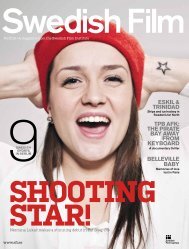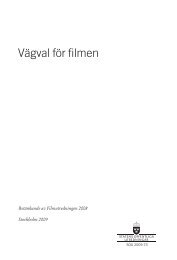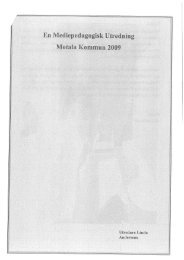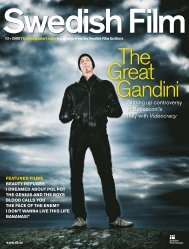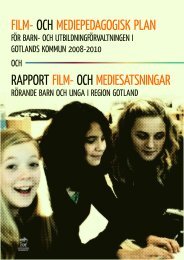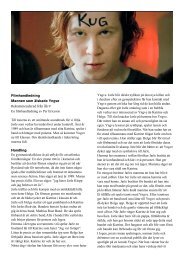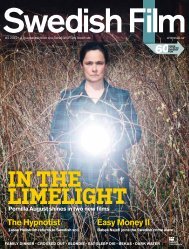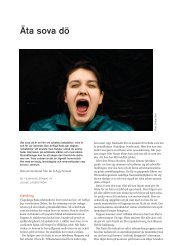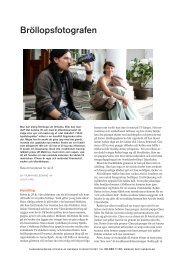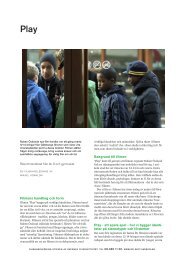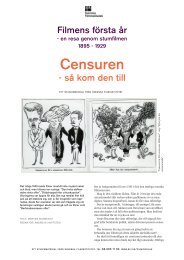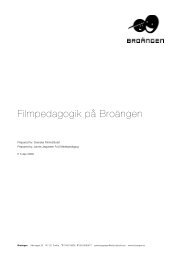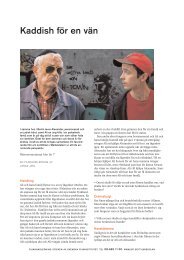Babes and booze - Swedish Film Institute
Babes and booze - Swedish Film Institute
Babes and booze - Swedish Film Institute
Create successful ePaper yourself
Turn your PDF publications into a flip-book with our unique Google optimized e-Paper software.
24<br />
Ruben Östlund: “When you watch the film<br />
you’re immediately struck by how amazingly<br />
hard the young actors have worked. The film<br />
has a very physical feel to it. There are lots of<br />
scenes that made heavy physical dem<strong>and</strong>s<br />
on the cast, <strong>and</strong> I think it makes the film all<br />
the better. When I can see that someone has<br />
made an effort, I feel more engaged as a viewer.”<br />
“The film for these guys has been rather<br />
like a sporting event. For certain scenes we<br />
set aside three days to shoot. We said: ‘at the<br />
end of three days we’ll be at our very best’,<br />
<strong>and</strong> by the end we were saying ‘now we only<br />
have five takes left’, <strong>and</strong> everyone appreciated<br />
that type of pressure, everyone gets pleasure<br />
from doing a good job.”<br />
for The boyS who play the main parts, successful<br />
takes resulted in pure jubilation.<br />
“After three days of shooting we travelled<br />
back by car down the main street in Gothenburg<br />
<strong>and</strong> they wound down the windows <strong>and</strong><br />
shrieked as if they’d just won a world cup final.<br />
I think it’s very important for them to realise<br />
that their sacrifices in the end led to<br />
something that was really good, to get the<br />
pleasure of putting in an effort that paid off in<br />
terms of results. In later life they can choose<br />
to use that energy as they see fit. I really hope<br />
that they’ve learned something valuable<br />
from the experience.”<br />
Despite certain similarities with Involuntary,<br />
the film set new challenges for the director.<br />
Firstly, it’s a sensitive subject. Östlund<br />
certainly didn’t want to tell some kind of<br />
Robin Hood story about the young robbers,<br />
but rather to show how people perceive the<br />
behaviour of others in predictable ways,<br />
without becoming predictable himself.<br />
Secondly, having made episode films that<br />
hang loosely together, this was the first time<br />
he had tackled a chronological story.<br />
“In my other films the scenes could have<br />
come in almost any order. But because almost<br />
all the scenes in Play take place in real<br />
time, I haven’t been able to create the drama<br />
through editing: it had to be there from the<br />
writing stage. It needed quite a bit of preparation<br />
in order to work.”<br />
someone said that there wasn’t a traditional<br />
screenplay for Play, but that it was a time<br />
line on a long, long roll of paper.<br />
“Of course I did write a traditional screenplay<br />
which we used to get the funding. But<br />
the timeline became a way for me to get a<br />
h<strong>and</strong>le on what was going on. Previously I’ve<br />
never written down the entire sequence of<br />
events for a film in such a way. We used it<br />
when we were shooting, <strong>and</strong> also when we<br />
were talking with our financial backers.<br />
You’re not a fan of too much editing.<br />
“You can achieve things in real time that<br />
are difficult to achieve through editing.<br />
“You can achieve<br />
things in real time<br />
that are difficult to<br />
achieve through<br />
editing”<br />
Small details crop up in relation to everything<br />
else that’s going on, <strong>and</strong> they st<strong>and</strong> out<br />
as equally important. I used the same techniques<br />
in Incident by a Bank. You can see a<br />
bank robber pressed down with his face in<br />
the dirt <strong>and</strong> probably experiencing the worst<br />
moment of his entire life. On the other side of<br />
the street someone’s eating ice cream <strong>and</strong><br />
two people who have been filming the robbery<br />
are discussing why there’s no zoom on<br />
the camera of their mobile phone. I’m very<br />
fond of shifts like that; it’s the way life is.”<br />
There are, however, invisible edits in<br />
many of the scenes in Play. These have been<br />
achieved using the high definition technology<br />
afforded by the RED camera.<br />
“Certain shots <strong>and</strong> camera movements<br />
are created during the edit. It means I can<br />
combine different takes without anyone<br />
thinking that real time has been interrupted.<br />
It also produces an interesting change in<br />
work roles: suddenly it’s not the cameraman<br />
who decides the shot, but the editor.”<br />
is Play a typical Plattform-film?<br />
“Yes, many of our films have their origins<br />
in something that interests us, a conversation<br />
or things like Erik (Hemmendorff) showing<br />
me that article. Another thing we agree<br />
on is that no script is finished just because<br />
you’ve arrived on the set. You see far too<br />
many films where it’s obvious that it has<br />
been squeezed into a finished screenplay,<br />
even though it clearly doesn’t work. Things<br />
might be damned hard to change at that<br />
stage, but you shouldn’t be afraid of hard<br />
work.” n<br />
PLATTFORM PRODUKTION



